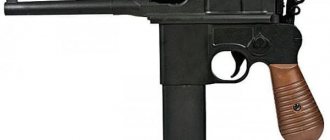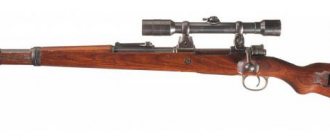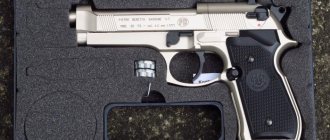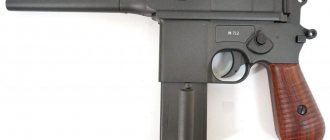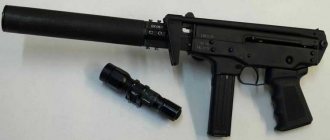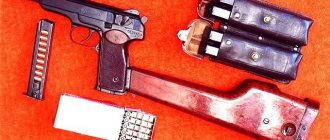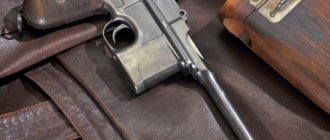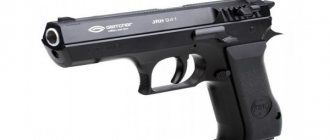Legendary weapons have always attracted the attention of most of the country's male population. It is thanks to the availability of pneumatic analogues for sale that many managed to get closer to the object of their dreams. Thus, Mosin and Berdan rifles, revolvers and Smith and Wesson, Makarov and Desert Eagle pistols appeared in the personal collections of weapons lovers. Many gunsmiths may be interested in another “toy” that can be used not only for collection, but also for entertainment. An American novelty, the Gletcher M712 (Mauser), an air pistol that can fire bursts, in no way inferior to a machine gun, has conquered the arms market. The German prototype of the legendary German-made weapon Umarex C96 (Mauser) will not be left without attention. But first things first.
Historical reference
“An ordinary pistol, nothing special,” any European will say when looking at a Mauser air pistol. But in the countries of the post-Soviet space, every man will definitely answer what kind of weapon it is, and in what films he saw it. Perhaps he will tell the story of the Mauser. After all, all the boys of the late 20th century knew more about weapons than today’s youth. It is for those boys that all kinds of models and pneumatic modifications of the legendary weapons are now available on the shelves.
The pneumatic copy is not the original, it does not have such enormous power, and it does not come with a stock, but there is that unforgettable feeling that allowed the pistol a century ago to become one of the most popular among the Russian-speaking population - respect for the owner and an increase in his self-esteem. After all, the bulky appearance, heavy weight and the possibility of automatic shooting blur the visible lines between a toy and a legendary combat weapon.
Design Features
- In terms of design, the pistols of 1910, 1914, and 1934 are virtually no different. Most of them are just cosmetic. The operation of these pistols is automatic with a blowback bolt.
- When firing, the barrel is motionless, but if disassembly is done, it is simply removed. The barrel is attached to the frame in a rather special way - using a valley rod, which is inserted in front under the barrel and also passes through holes in the stops made on the lower surface of the barrel.
- The trigger mechanism is non-self-cocking (single action), striker-fired.
- The manual safety is located in the cutout of the handle cheeks on the left.
- The design includes a slide stop, but it can only be turned off by inserting another magazine. The magazine release is located at the base of the handle.
- The assembly of the pistol is “revolver”, so its disassembly is slightly unusual; the box magazine is located in front of the trigger guard.
- The pistol is one of the most massive types of automatic pistols, the automation of which is based on the use of recoil energy from a short-stroke barrel.
- Disassembly of the pistol indicates that the Mauser design is quite successful, it has the highest accuracy and range, excellent survivability in combat conditions and massive cartridges. But it also has some drawbacks - these are huge dimensions and weight, a circuit that affects the complexity of reloading.
Legal purchase
A pressing issue for most buyers is the legality of purchasing, storing, transporting and using air guns. You should not trust this question to friends, neighbors or strangers. It is enough to refer to the law “On Weapons”. Like any gas-cylinder weapon, the Mauser air pistol does not require any permits. The submachine gun with a caliber of 4.5 mm is smooth-bore, and its muzzle energy does not exceed 7.5 Joules. To make life easier for the owner and provide answers to all questions regarding legality, most sellers include a certificate with the weapon that specifies the tactical and technical characteristics of the pistol. Also attached to the certificate is a document in which the law “On Air Weapons” of the state in which it is sold is printed. Problems may arise only for persons under eighteen years of age. In such cases, the purchase must be made by the parents.
Creation Story
The Waffenfabrik Mauser enterprise went to Paul Mauser after the death of his brother Wilhelm in 1882. The awards of the Mauser arms company by that time were recognized, thanks to the production of a proven long-barreled gun. The manager and manager of the experimental workshop at the Mauser enterprise was Fidel Federle, who, together with the brothers Friedrich and Joseph Federle, was passionate about creating a self-loading pistol.
custom_block(1, 41617674, 2218);
The drawing of the pistol was created without Paul’s knowledge, and according to some sources, even against his will. The design of the pistol corresponded to the era of that time - the magazine was placed in front of the trigger guard, it was similar to the designs of the first pistols by Laumann, Reiger or Bergman. For ammunition, the brothers initially use widespread and affordable cartridges with a Borchardt 7.65 mm bottle sleeve. It was on the basis of this cartridge that a drawing was soon developed and the 7.63 mm Mauser cartridge was created.
At first, the pistol was called Feederle Pistol or P-7.63. But Paul Mauser did not immediately find the work being done, so the gun was actually ready. And although Paul was dissatisfied with the hidden work, his business acumen prevailed over his ambitions. Therefore, he not only did not prohibit the work on creating the new model, but he himself became involved in its improvement. Paul Mauser was aware of the prospects of the newest model, as well as the likely commercial success and the opportunity to occupy a niche place in the market for short-barreled guns. In 1895, a model of the K-96 Mauser pistol fired its first shot. In the same year, Paul Mauser patented the pistol, including its design and other features in countless patent offices around the world.
The first pistols were made in 1896, and serial production began in 1897, which continued until 1939. During this period, more than a million K-96 pistols were produced. One of the reasons why this pistol became popular was its enormous power at that time. The pistol was positioned as a small, lightweight carbine. It was practically a carbine. This was due to the fact that such a “carbine” had a wooden holster, which was used as a butt, and the bullet hit at a distance of up to 1000 m. The Mauser was widely featured in the First World War and the 1914 revolution. The Mauser's supplies were so significant that they were also used during the Great Russian War.
custom_block(1, 6333306, 2218);
Weapons for the Russians
Judging by numerous reviews from new owners, the Gletcher air pistol is aimed at the Russian market. After all, only a Russian person, for the sake of similarity with the original, will agree to turn a blind eye to the mass of the purchase, unlike Europeans, for whom convenience and weight come first. The weight of the pistol is impressive. Thanks to the metal structure, when fully loaded with ammunition, its weight reaches up to one and a half kilograms. The movement of the shutter when fired is like the original - another plus in favor of the pistol, which, in addition, is easy to disassemble and can be modernized. Pleased with the presence of the original shutter locking system. In general, when purchasing, many new owners may have the feeling that something was mixed up at the factory and, despite the law on pneumatic weapons, they sold the combat unit.
Comparison of Mauser C96 with analogues
In 1902, competitive tests were carried out on several personal small arms systems for arming the German army. They included Mauser C96, Borchardt C93 and Luger P-08 pistols. Several other weapon systems took part in the tests, but due to extremely unsuccessful designs, their testing was not completed.
Borchardt C93
It was a very successful pistol of its time. Traces of the design of this weapon can be seen in the Mauser S96 in question. But Borchardt’s pistol had one undeniable convenience - combat accuracy was achieved by the almost ideal weight distribution of the weapon, which was indirectly ensured by the cartridge supply system located in the form of a magazine in the handle.
We recommend reading: The legendary Nagan system revolver: from 1886 to the present day
The advantages of the pistol were the accuracy of the shot, the ability to use the holster as a butt, and ease of reloading.
The disadvantages were low resistance to dirt, the size of the weapon and its weight, as well as high cost.
Luger P-08
Being a kind of continuation of Borchardt's design, the Luger pistol managed to reduce the overall weight of the weapon and achieve great accuracy thanks to the handle with an anatomical slope and an easy trigger. The pistol used a cartridge of its own design, 9x19 mm Parabellum, with increased stopping power compared to 7.63 mm cartridges.
But it was not without its drawbacks - the Luger inherited an open-type bolt from the Borchardt system, which is extremely unstable to contamination.
Reasons for increased demand
All legendary airguns - pistols, rifles and revolvers - are designed in most cases to fire one shot after each reload. But before the advent of the Mauser, there was nothing on the market for automatic fire. Strange parodies from Russian and American manufacturers of assault rifles intended for special forces do not count. What's scary about them is not only their very light weight due to the use of plastic instead of metal, but also their appearance and build quality. The technical characteristics of pneumatic submachine guns also leave much to be desired. While in the Russian model you can tighten the bolts or insert bushings after active shooting, the American version cannot be repaired at all. The same cannot be said about the Mauser: the pneumatic submachine gun is popular because it has high fault tolerance, is easy to disassemble and assemble, and does not have plastic structures.
Device
Mauser used a typical carbine layout - a box magazine was placed directly in front of the trigger guard. The magazine is loaded using a clip inserted into the receiver cutout located on the receiver directly behind the barrel. The design used an open trigger mechanism. The reloading mechanism uses recoil energy when fired.
A rigid holster - the butt was attached to the buttplate of the handle, and was used when shooting at long distances, essentially turning the weapon into a carbine. In later models, the holster served as a butt-rest, and was attached mainly when it was necessary to conduct automatic fire.
Description of design
The Mauser C96 is built according to the classic design of a blowback weapon. The barrel bore is locked due to the larva that engages the barrel and the bolt. The design of the trigger allows only single fire, with the exception of the Schnellfeuer 712 model.
Structurally, it can be divided into the following elements:
The Mauser frame, which has a skeletal function, is in turn divided into a base and an insert. The base consists of a magazine shaft with a spring feeder, a safety bracket with an installed trigger and mainspring, as well as a handle with cheeks and a mount for the butt. The insert represents the main structure of the firing mechanism and is mounted in the frame.
We recommend reading: Yarygin pistol: development history and technical characteristics
The barrel with the bolt group is attached to the frame. The barrel is made of a single element with the receiver, which houses the bolt, return spring, firing pin and bolt stop button. On the top of the receiver there is a sector sight with divisions up to 1000 meters, a window for the cartridge extractor, which also serves as a charging hole. On the barrel, in its muzzle, there is a rectangular front sight.
How the gun works
The C96 automatic operates on the principle of using the recoil energy of the bolt with a short barrel stroke. The barrel is locked using a vertically swinging cylinder. The pistol has a permanent, non-removable double-row magazine, which is filled only from the top using clips. When the trigger was pressed, the cylinder was released from compression, and the bolt moved back under the action of powder gases, extracting the cartridge case. At this time, the feeder fed the cartridge to the chamber, and the bolt, having reached the extreme degree of compression of the return spring, moved forward, driving the cartridge into the breech of the barrel. When the trigger was released, its limit switch pressed the cylinder, locking the bolt.
The safety is located on the left side of the weapon, directly next to the trigger. The fuse can be controlled using your thumb.
Cocking is possible by manually pulling the bolt back.
Cartridge Mauser
During the development of the initial version of the weapon, the 7.63x25 Borchardt cartridge of the 1893 model was used. But after the first shooting, Paul Mauser demanded that the cartridge be strengthened. But the company’s designers took a different route - they did not invent a new cartridge, but simply slightly reduced the caliber and mass of the bullet, as well as switching the cartridge to smokeless powder, and actually remade the cartridge, giving it the name 7.63x25 Mauser. The cartridge demonstrated enviable piercing power - at a distance of 15 meters it pierced ten pine boards 2.5 cm thick.
Specifications
It is a pity that the Mauser is not produced for all calibers of air guns. This can be considered its only significant drawback. Fans of large calibers will have to be content with the standard 4.5 mm with a muzzle energy of about three Joules. Shooting steel balls is not intended for rifled weapons, so the barrel of the Mauser is smooth, but this does not prevent it from producing accurate shots with excellent accuracy. Unlike more expensive submachine guns, the Gletcher air pistol gives its owner the choice between single and automatic shots. For this purpose, there is a two-position regulator on the body. The initial bullet speed declared by the manufacturer is 110 meters per second. Many owners, judging by their reviews, assure that even with automatic shooting, the declared bullet speed is maintained. In automatic mode, a 12-gram CO2 cylinder is enough for two full discharges of the clip.
Gletcher Grach NBB - Yarygin pistol (rook)
Pneumatic glacier pistol Grach NBB
Black, as befits a rook, this pistol is also very similar to the original. For this purpose, it even has the gas cylinder pressure screw hidden inside the body. However, it does not have a blowback system, although the shutter is made movable, like the frame. There is a double-sided safety - you can shoot with both hands. The parts are mostly metal, except for the magazine heel, grip lining and ejector window.
Peculiarities
- Charges in the magazine – 20;
- speed of a flying bullet – 115 m/s;
- USM – double;
- weight – 0.96 kg;
- food type – 12 g CO2 canister;
Advantages and disadvantages
Pros:
- Ability to shoot with both hands;
- Full size store;
- high shooting accuracy;
- Convenience - the gun fits well in the hand.
Minuses:
- To replace the cylinder you need a hexagon;
- lack of blowback system;
- no sight adjustment;
- There is a groove for releasing the magazine on only one side.
Competitors are not asleep
On the market, a buyer may be faced with a dilemma - two identical-looking Mausers, in the same price category, but from different manufacturers. Yes, in addition to the American company Gletcher, there is a German representative of the Umarex company on the market - the Mauser C96. Without paying attention to the inscriptions, you can distinguish them from each other only by picking them up. The plastic “German” is inferior not only in weight. Its dissimilarity with the original may cause indignation of the buyer. The plastic bolt and receiver are clearly not associated with the legendary Mauser of the last century.
In the huge list of negative reviews received from Umarex owners and fans, there are two “rays of light”. Firstly, the pistol is quite light and very comfortable to shoot. Secondly, the initial speed of the bullet is about 130 meters per second and exceeds the “American” performance. The result is a completely acceptable competitor.
Disassembly
Complete disassembly of the model is carried out only during repairs in specialized workshops. The barrel is cleaned with a brass or steel cleaning rod placed in plastic without disassembling the gun. If it is necessary to partially disassemble the model (the ramrod unwinds in the barrel, foreign parts get inside the structure), the following procedure is recommended:
- unscrew the screw on the right cheek of the handle and remove the plastic cover;
- Unscrew six screws on the side surface of the body and another screw under the barrel;
- open the receiver by prying it with a screwdriver;
- Unscrew the screw securing the return spring.
After these manipulations, access to the barrel, secured by two bushings, opens. The bolt group is removed along with the blowback mechanism, after which it can be cleaned and lubricated with pneumatic oil. During incomplete disassembly, attention should be paid to the safety of screws and springs, which are easy to lose when opening the receiver.
Pistol Mauser S96 (K-96) disassembled
About supplies
Airgun bullets deserve special attention. Manufacturers' recommendations regarding ammunition specified in the technical documentation for the pistol cannot be ignored. The manufacturer strongly recommends using very expensive shooting balls of its own design for good reason. There is a “pitfall” that is not written about in the technical documentation. The Mauser pistol, a pneumatic analogue of a military weapon from an American manufacturer, was equipped with two barrels due to its reduced caliber to be similar to the original. One barrel is made of steel “for appearance’s sake”, and the second, placed inside the steel one, for a caliber of 4.5 mm, is made of brass. As you know, brass is wear-resistant, but in terms of strength it is much inferior to steel; accordingly, uneven steel balls, purchased for pennies, will quickly destroy the inner surface of a smooth pistol barrel. It’s easier with the German manufacturer Umarex. A high-quality steel barrel allows you to shoot cheap balls, which will allow the user to significantly save on ammunition.
Gletcher TT NBB – Tula “Tokarev”
Air gun glacier TT NBB
Repeats the legendary Tokarev model, both visually and in dimensions. It has a blowback, a hidden cylinder screw and a single action trigger. Equipped with an active bolt stop. Fire can only be fired in single shots. The pistol body is completely metal.
Peculiarities
- Charges in the store – 18;
- speed of a flying bullet – 110 m/s;
- USM - single;
- weight – 0.6 kg;
- food type – 12 g CO2 canister;
- blowback system
After the next shooting, did something go wrong? An airgun repair manual can help with frequent breakdowns. A detailed description of replacing parts, cleaning, lubrication and everything about proper care of pneumatics. Experienced hunters are advised to choose an air rifle for hunting with a PCP system. Read about such rifles.
Advantages and disadvantages
Pros:
- Compact and lightweight;
- blowback system;
- the presence of a shutter stop;
- fast magazine reloading.
Minuses:
- The sight is not very convenient - your eyes get tired when shooting for a long time;
- incomplete disassembly is impractical - you can scratch the shutter;
- weak return spring;
- The store is not full size.
The first modification of the Mauser
Studying pneumatic weapons, prices and reviews about them, any buyer could notice that the combat Mauser is positioned as a light carbine, which had a special holster used as a butt. The idea that such amplification was needed purely for military weapons, for which shot accuracy and firing range with minimal recoil are important, will return to the new owner again. The moment the powerful Mauser air weapon fires its first shot. With a weapon weighing one and a half kilograms, shooting, even with two hands, is problematic. All that remains is to either get used to it or make a butt for the pistol. Fortunately, ready-made proposals have already appeared for the new product in the form of a holster-stock, which are offered at an affordable price and, along with high quality workmanship, have a simple and reliable attachment device to the pistol handle. It is worth noting that installation of the stock is possible only on an American-made pistol, because the manufacturer equipped the handle with a special groove for modernization. The German analogue from Umarex does not have mounting grooves.
Mauser M712 pistol
The Mauser M712 is an automatic pistol that had attachable 20- and 10-round magazines. It began to be produced in 1932. The gun was equipped with a Nikla trigger mechanism. The rate of fire ensured a rate of fire of 850 rounds/min. This model with a 20-round magazine and also an attached holster-butt was used as a small-sized submachine gun. Production of the M712 continued until April 1938. During this period, approximately 95,000 M712s were produced. Approximately 10,000 of these pistols were purchased for the SS troops. This weapon was also used by reconnaissance and sabotage units of the Wehrmacht.
Elimination of the American "gift"
Most owners who purchased a powerful air gun from the American company Gletcher, as a result of frequent firing of a pistol in bursts, discover a “gift” from the manufacturer in the form of a weak fastening of the firing switch. By moving the toggle switch to the “single” firing position, the pistol is switched to firing in bursts. Judging by the reviews of many experts in the field of pneumatic weapons, the technical device of the firing switch cannot be modernized. When you contact the service center, you may receive a response suggesting that you remove all the grease in the switch mechanism. In the future, lubrication can only be done with silicone spray. This strange solution leads to slight jamming in the fire switching mechanism, but completely eliminates the problem. In general, it is very unpleasant to realize that the American leader in the production of air guns has introduced an expensive copy of a legendary weapon with such a “gift” to the market.
Origins of the legend
The company itself was founded about one hundred and fifty years ago. Two brothers, Wilhelm and Peter, whose father devoted almost his entire life to serving in the royal arms company, founded a company for the production of firearms.
Despite the fact that the firing range was stated to be almost a kilometer, when the weapon was held motionless, the bullets were scattered with such an amplitude that there was no need to talk about aimed shooting.
A total of twenty-two Mauser models were produced. An interesting fact is that legendary weapons became popular in different countries at different times.
For example, the Chinese appreciated the new product quite late - they liked it only in the era of militarism. However, as they say, “having tried it out,” the specialists of the Celestial Empire even created a couple of additional modifications of this weapon.
As for pneumatic versions, there are only two of them at the moment. We will talk about them further. It is also worth looking at the article about the Walter pistol from the war.
About optical devices
Focusing on the target firing range of 10-15 meters, the manufacturer dealt harshly with fans of weapon modernization. By installing an adjustable rear sight and front sight as a sighting device, the manufacturer cut off the possibility of further improvement. But for lovers of modernization there are no barriers, especially for those who have chosen the Gletcher M712 (Mauser). The air pistol is made of metal, including the sighting device, which, after a little modification with a dremel or cutter, turns into something like a Picatinny rail. Such modernization opens up a world of enormous opportunities for those who like to modernize legendary weapons. A collimator, laser or optical sight will easily fit onto a homemade rail.
In general, after a thorough examination of the metal body of the Mauser pistol, the Kulibin beginner will be satisfied. If you have a welding machine and a little desire, it won’t take much effort to create your own modification of the legendary Star Wars weapon.
Operation and combat use
- Austria-Hungary - a number of C96s were purchased to equip officers.
- Bolivia - a small amount of C96 was purchased to equip the army.
- Brazil - 500 Schnellfeuer 712 purchased from Spain to equip the police.
- Great Britain - privately used by colonial officers.
- Israel - a small number of C96 1916 were used in the armed forces of the IDF.
- Iceland – a small number of weapons were purchased from Spain to arm the police.
- Spain - Astra 900 models of its own production were used to equip secret service personnel.
- Italy - about 6,000 thousand pieces were purchased for the fleet command.
- Türkiye - about 1000 pieces were purchased specifically for the Sultan's security service.
- Russian Empire - weapons are recommended for purchase with personal funds by ground forces officers.
- Russia - used as a reward weapon.
- USSR - used as a service weapon for Red Army officers and partisan detachments.
- Germany - a small number were in service with small detachments of the Wehrmacht and SS.
- Ukraine - used only as a reward weapon.
- Finland - during the First World War, a small batch was supplied to arm nationalist formations.
Shot Boost
The great desire to improve pneumatic weapons, the prices of which range from 7-10 thousand rubles, and the availability of purchase led to the emergence of pre-pumping systems, popularly called PCP. At first, this system was installed on short-barreled rifles with the trigger moved to the front of the butt, and later all owners of conventional rifles became interested in it. Seeing an increase in bullet speed when changing the technical characteristics of an air gun using PCP, many pistol owners have subjected their “toys” to modernization. This improvement also affected the Mauser pistol. The pneumatic analogue, when replacing the standard gas cylinder with a pre-pumping system with a high-pressure reducer, allows you to shoot steel balls at a speed of 160 meters per second. This is the only positive thing after modernization, no matter what the happy owners say. Judging by the reviews, everything else is completely negative.
- The weight of the weapon is comparable to a rifle, but shooting is extremely inconvenient due to the lack of a full stock.
- The absence of a rifled barrel causes the ball to move chaotically, which flies into the unknown at a distance of more than 25 meters. You can completely forget about aimed shooting.
- When firing in bursts, one clip “eats” a fully filled tank of 200 atmospheres. And if there is a gearbox, burst shooting does not work.
Principle of operation
When a liquefied gas cylinder is screwed in, it is pierced by a hollow needle and carbon dioxide enters the pneumatic chamber. After pressing the trigger, the trigger acts on the bypass valve, as a result of which part of the gas leaves the chamber through the barrel and accelerates the ball.
During the shot, the “blowback” system operates, using carbon dioxide pressure for reloading - retracting the bolt frame and cocking the hammer. This gives a realistic feel to the gun's behavior and allows for recoil caused by the sudden movement of the moving parts.
A significant number of shots before recharging the cylinder (100-110) indicates a well-thought-out design of the mechanism, using only a small part of the gas energy.
